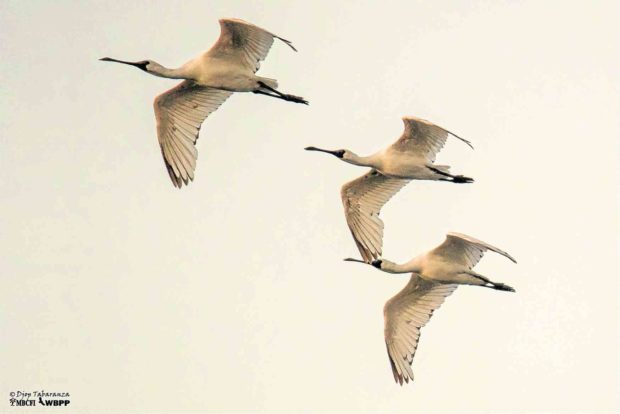
SURPRISE VISITORS Three black-faced spoonbills fly over Bangkung Malapad islet in Sasmuan town, Pampanga province, on Sunday, a once-in-a-century sighting that has become a cause for celebration among local bird watchers. —PHOTO COURTESY OF DON GEOFF TABARANZA/WILD BIRD PHOTOGRAPHERS OF THE PHILIPPINES
Three globally endangered black-faced spoonbills (Platalea minor) were seen flying over Bangkung Malapad islet in Sasmuan town, Pampanga province, on Jan. 12, more than 100 years after its last recorded sighting in Manila Bay.
The bird species is a rare migrant in the Philippines, which is within its confirmed wintering range along with coastal areas in China (including Hong Kong and Macau), Japan, South Korea, Taiwan, Vietnam, Cambodia and Thailand.
“Philippine sightings of the black-faced spoonbill in the past decade have relied on citizen science,” said Arne Jensen, an associate expert of Wetlands International and records committee chair of the Wild Bird Club of the Philippines (WBCP).
These are limited from one to three reports from Puerto Princesa City in Palawan province; Candaba in Pampanga; Bicol River Estuary; Olango Island in Cebu province; and Batan Island in Batanes province, according to the WBCP and the International Black-faced Spoonbill Working Group of the East Asian-Australasian Flyway Partnership.
The last recorded sighting of the black-faced spoonbill in Manila Bay was in 1914, according to “A Guide to the Birds of the Philippines,” written by Robert S. Kennedy, et al. (Oxford, 2000).
WBCP members Amado Bajarias Jr., Maia Tañedo, Don Geoff Tabaranza and this writer reported the three black-faced spoonbills as circling thrice at 6:30 a.m. on Saturday, the first on their list as part of assisting with the 2019 Asian Waterbird Census and site assessment.
Jensen assigned the team to Bangkung Malapad as part of a multisite count program, in collaboration with Wetlands International Philippines, Department of Environment and Natural Resources-Biodiversity Management Bureau, and the WBCP.
Multicountry effort
One of the sighted birds has two colored bands on its right leg.
“They appear to be either orange or red and yellow or white,” said Desmond Allen, author on Philippine avifauna.
“The black wing tips of the bird indicate that it is not an adult bird and less than 5 years old,” he said.
According to Allen, the Black-faced Spoonbill Conservation Network, an online platform launched by the Taiwan Black-faced Spoonbill Conservation Association, lists details of all individuals of this species that have been banded with colored rings, so that individual birds can be recognized and reported by birdwatchers and bird photographers throughout the region.
“This information is crucial to understanding the migratory routes and stopover locations that are essential for the conservation of this beautiful, endangered species,” he said.
Land use conversion
The black-faced spoonbill is the only spoonbill species that remains categorized as endangered by the International Union for Conservation of Nature Red List.
Its migration route along the East Asian-Australasian Flyway means that concerted multicountry effort is needed to guard against indiscriminate land use conversion for commercial and residential purposes, Jensen said.
ID BAND Black-faced spoonbills banded with colored rings, like the one spotted in Sasmuan, Pampanga, can be reported by birdwatchers and bird photographers throughout the region. This contributes to understanding migratory routes and stopover locations essential to the conservation of this endangered species. DON GEOFF TABARANZA / WILD BIRD PHOTOGRAPHERS OF THE PHILIPPINES
“Some 60 percent of around 150 migratory bird species recorded in the Philippines are associated with water. Habitat conversion, however, has led to over 77 percent loss of our mudflats, shell banks and sandbars in Manila Bay from 1977 to 2017,” he said.
Jensen said protecting migratory bird populations and their habitats needed implementation of policy agreements among governments.
Over the past two years, the Philippine government has been at the forefront to increase protection and restoration of intertidal and other coastal habitats through new agreements among member states of the Convention for Migratory Species and of the Ramsar Convention on Wetlands of International Importance, especially for waterbirds.
“A habitat that sustains wildlife and ecosystems is ultimately best for people. Healthy wetlands not only protect shorelines and millions of migratory waterbirds, but also mitigate flooding, absorb excess rainwater, filter pollution and replenish groundwater supply,” Jensen said.
Life-saving decisions
Ongoing interventions that include coastal preserves for the black-faced spoonbill have helped increase global numbers from under 300 in the 1980s to 3,941, based on the 2018 International Black-faced Spoonbill Census.
Yu Yat-tung, Hong Kong Bird Watching Society research manager who coordinates the annual regionwide census, said these gave grounds for optimism for people still working toward doubling the numbers for a viable population.
The birds’ concentration in a few sites also makes them vulnerable. Taiwan, for example, accounts for nearly 60 percent of the sightings, the largest number recorded in any country.
“The involvement of volunteers who help count is a good example of how citizen science and researchers join together for surveying a globally threatened bird,” said Yu, who is gearing up for the 2019 Black-faced Spoonbill Census on Jan. 25 to 27.
“Tracking to inform decisions that preserve wintering and nesting habitats benefits not only a charismatic species but all wetland birds and marine birds, and people just as much,” Yu said.
Not too late
Jensen noted that Manila Bay was suffering irreversible damage to its ecosystems and biodiversity in most of the bay areas, “but it is not too late to restore some of the coastal wetland while improving the bay’s water quality.”
He said 70 percent of around 200,000 waterbirds found in the winter months in the coastal part of Manila Bay survive in just 10 smaller areas at river mouths and coastal mudflats.
Jensen cited the “immediate and urgent need” to protect and restore these areas of around 10,000 hectares.
“Reclamation and other development of these areas will have a further, dramatic negative impact on the populations of these waterbirds, of which an increasing number of species are threatened with global extinction. If they are to survive, every hectare of protected wetlands counts,” he said.